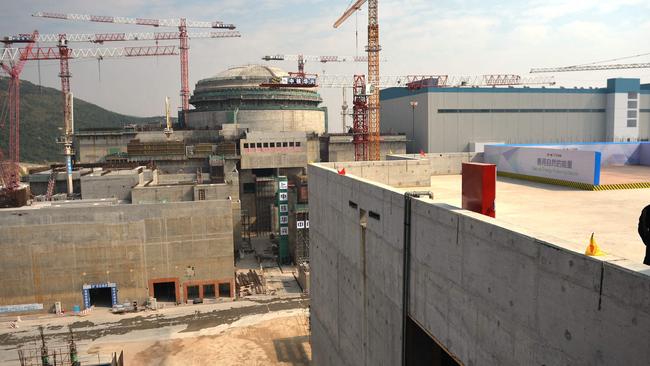China ‘raised safety limits after leak at nuclear power plant’
Chinese authorities responded to a leak at a nuclear power station by raising safety limits to keep it open, Washington has been told.

Chinese authorities responded to a leak at a nuclear power station that posed an “imminent radiological threat” by raising safety limits to keep it open, Washington has been told.
Instead of closing the power plant at Taishan in the southern province of Guangdong, officials increased the authorised level of radiation, Framatome, a French company that partly owns it, is believed to have told US investigators.
CNN reported that the US government has spent the past week assessing a report of a leak at Taishan, but an unnamed US officials cited by the TV network said the Biden administration did not believe the facility was at “crisis level”.
Following reports of a leak, EDF, the majority owner of Framatome, said operators of the nuclear power plant were fixing a “performance issue”, but gas emissions carried out to do that were within acceptable limits.
EDF said the plant’s No. 1 reactor experienced a build-up of noble gases in its primary circuit, which is part of the cooling system.
But an EDF spokesman, who asked not to be named, insisted the issue was being handled.
“We are not in a scenario of an accident with a melting core,” he said. “We are not talking about contamination, we are talking about controlled emissions.”
Noble gases are elements which have low chemical reactivity – in this case it was xenon and krypton.
Gas leaked after the coating on some fuel rods had deteriorated, the spokesman said.
The gases were collected and treated as part of a process to remove any radioactivity before their release, which was normal and “in accordance with regulations”, he added.
Framatome said in a statement that the plant was operating “within the safety parameters” despite the “performance issue”. EDF called an extraordinary meeting of the plant’s board over the matter.
David Fishman, manager at energy-focused consulting group The Lantau Group, said a cracked fuel rod could potentially cause a small release of fission materials into the cooling loop, “where it wouldn’t normally be”.
“Failed fuel or cracked fuel is a fairly normal and common – undesirable, certainly – but not uncommon phenomenon in the nuclear fuel industry,” he said.
Citing a letter from Framatome to the US Energy Department, CNN said the warning included an accusation that the Chinese safety authority was raising the acceptable limits for radiation outside the facility in order to avoid having to shut it down.
US officials have conferred with both French and Chinese officials about the matter, CNN said.
The Department of Energy did not immediately respond to a request for comment.
The operator of the station, state-owned China General Nuclear Power Group (CGN), said “the environmental indicators of Taishan Nuclear Power Plant and its surroundings are normal”.
It did not refer to any leak or incident at the power station, which it said meets “the requirements of nuclear safety regulations and power plant technical specifications”.
The International Atomic Energy Agency, the UN’s nuclear watchdog, said it had contacted its counterpart in China regarding the issue.
“At this stage, the agency has no indication that a radiological incident occurred,” the IAEA said in a statement.
A problem with a cracked fuel rod would have to be logged by the Chinese nuclear safety administration with a mitigation report to fix the problem, Mr Fishman said.
He said Framatome possibly reached out to the US to seek approval for its work at Taishan because CGN has been blacklisted by Washington.
“If (Framatome) were going to transfer over any information that they have gotten from working in the US, they would have to apply for an exemption … because CGN is on the US entity list,” he said.
“It is a no-fly zone for any US information, any information or data or technology or IP to go to China.”
Powered up in 2018, the Taishan plant was the first worldwide to operate a next-generation EPR nuclear reactor, a pressurised water design that has been subject to years of delays in similar projects in Britain, France and Finland.
EPR reactors have been touted as promising advances in safety and efficiency over conventional reactors while producing less waste.
Nuclear plants supplied less than 5 per cent of China’s annual electricity needs in 2019, according to the National Energy Administration, but this share is expected to grow as Beijing attempts to become carbon neutral by 2060.
China has 47 nuclear plants with a total generation capacity of 48.75 gigawatts – the world’s third highest after the United States and France – and has invested billions of dollars to develop its nuclear energy sector.
AFP



To join the conversation, please log in. Don't have an account? Register
Join the conversation, you are commenting as Logout